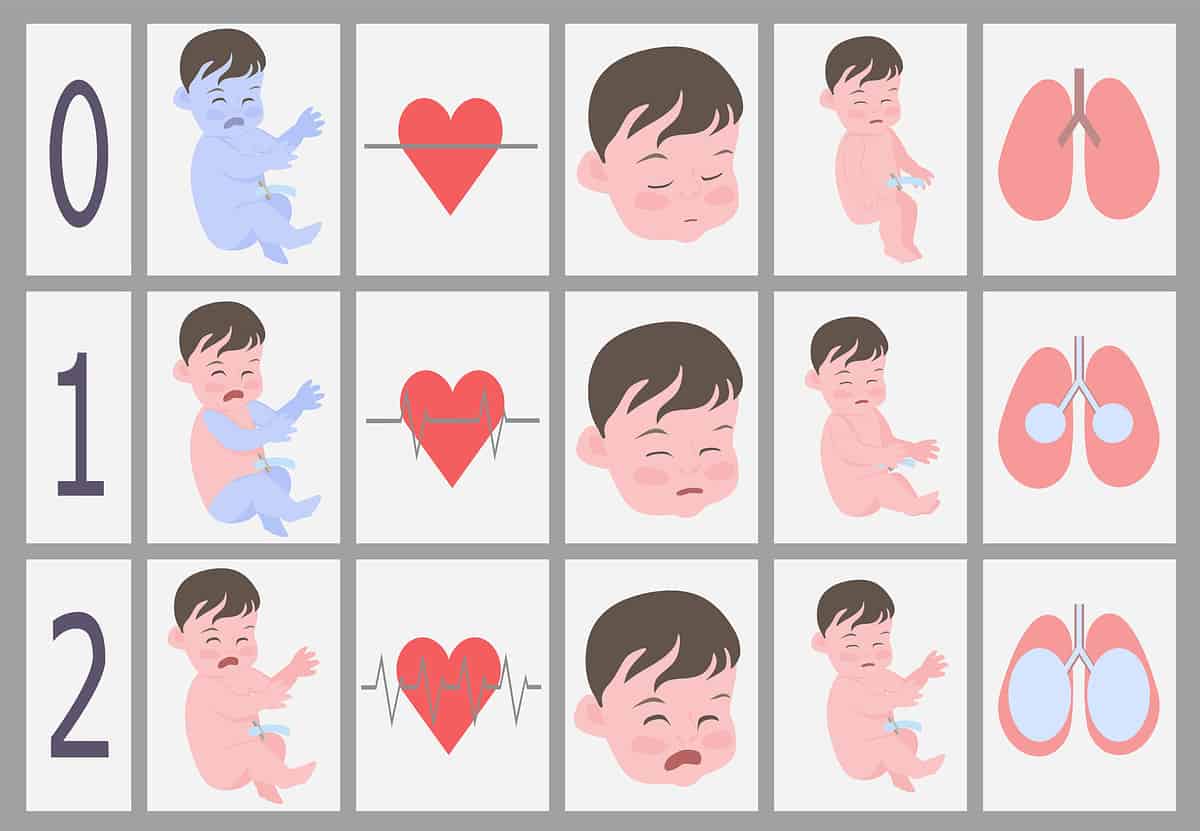There’s nothing quite like the feeling of holding your baby for the first time. As soon as your bundle of joy is born, you’ll be completely focused on your little one and while you’re soaking in all the newborn snuggles, your care providers will be preparing your baby for something called the Apgar test. This standard newborn test is a way to determine the health of your baby immediately after birth. If you’re not sure what the Apgar score measures for, an Apgar chart can be an effective way of showing you what’s normal.
The Apgar test isn’t anything scary for your baby. It’s simply a quick way to determine how your baby is doing outside the womb and how they can care for your baby. Keep reading to determine what the Apgar score means and how to read the Apgar chart.

©Aiana/Shutterstock.com
How to read the Apgar chart
The Apgar test is a quick test performed on newborns right after they’re born. For most babies, the test is given 1 minute after birth and 5 minutes after birth. The results of this test are meant to show the healthcare provider how well your little one handled the birthing process and how well they're adjusting to life outside of the womb.
Apgar is actually an acronym that shows what the test is measuring for, and each category is scored as a 0, 1, or 2. The parts of the Apgar tests are appearance, pulse, grimace response, activity, and respiration. A 2 in each category is the highest score, but most babies don’t score that high.
When healthy babies don’t receive the highest score on the Apgar test, it’s usually due to their appearance or skin color. To score a 2 on appearance, your newborn’s skin must be entirely pink. However, it’s common for babies to have blue hands and feet after birth since the blood and oxygen in their bodies are circulating to their brains, kidneys, and lungs instead of their limbs.
The Apgar chart provides a visual of each category to help you understand what they’re looking for during the test and what may cause your baby to give a low or high score.
How Is the Apgar test calculated?
Each category on the Apgar test represents an important sign of vitality. Even though some variations, such as blue hands or feet, may be normal in a newborn, the test is a quick way for doctors to determine the health of your baby. Let’s take a closer look at each category on the Apgar test and what doctors are looking for.
Appearance (or Skin Color)
The appearance category measures the skin color of your baby after birth. Although it’s common for babies to look a little blue, the healthcare provider is looking for pink skin.
- 0 means the skin is blue or pale blue
- 1 means the skin is pink but their arms and legs may be blue
- 2 means their skin color is all pink
Pulse (or Heart Rate)
The next part of the test is how well your baby’s heart is beating after birth.
- 0 means there’s no heartbeat
- 1 means there are fewer than 100 beats per minute
- 2 is a healthy heart rate of more than 100 beats per minute
Grimace Response (or reflex)
The grimace response is to measure your baby’s reflexes by testing how they react to external stimulation.
- 0 means there’s no reflex or response
- 1 means there’s a grimace but no other reaction
- 2 means there’s a grimace as well as another reflex such as a cry
Activity (or Muscle Tone)
Activity measures the muscle tone of your baby, including how well they can move their arms and legs around.
- 0 means their muscles are limp or floppy
- 1 means there is minimal flexing of the muscles in the arms or legs
- 2 means they are actively moving
Respiration (or Breathing Rate)
Breathing rate will determine how well your baby is breathing and if they need any assistance or are breathing well on their own.
- 0 means there’s no breathing rate
- 1 means they have slow or irregular breathing or a weak cry
- 2 means they have normal breathing and a strong cry
These are the factors your doctor or midwife will look for when evaluating your baby. The test is done twice after birth to ensure the most accurate results.

©davidsunyol/Shutterstock.com
What Does the Apgar Score Mean?
As a new parent, it’s normal to worry about your baby and look for reassurance that everything’s okay. When it comes to a test like Apgar, the score doesn’t necessarily indicate that something serious is wrong. The test is a quick way to measure how your baby is doing, but sometimes your baby may just need time to adjust to life outside the womb. A score of 7 or above typically means your baby is healthy. It’s unusual for babies to score a 10, even if they’re perfectly healthy because bluish skin is common after birth.
Your baby will be tested a second time 5 minutes after birth to get the most accurate results. If your baby had a low score and it doesn’t improve by the second test, they may test your baby again at 10 minutes. Depending on the results, your healthcare provider will determine the best course of action for treating your baby.
What if My Baby Has a Low Score?
There are many factors that can lead to a low score on the Apgar test. In fact, your baby is more at risk of scoring low if you have any of the following factors:
- Complications during pregnancy
- C-section
- Premature baby
- Complications during birth
If your baby does receive a low score, it’s important to remember that they’re in good hands and your baby’s doctor will work to address any issues. How the doctor will treat your little one depends on what part of the test they scored low on. If your baby scored low on breathing rate, they may give your baby oxygen until they’re able to breathe well on their own. If your baby has bluish skin, they continue to monitor your baby to ensure their circulation improves.
Remember, if your baby doesn’t score well on the Apgar Test, it doesn’t necessarily mean that there’s something wrong with your baby. Sometimes, the baby is having a hard time adjusting after birth and just needs some assistance.
What Is a Normal Apgar Score for a Baby?
The Apgar Score is determined by putting the results of the different categories together. For example, if your little one scored a 1 across the board in each category, their total score would be five. A 7 or above is considered healthy, but the score can greatly vary depending on the circumstances surrounding the pregnancy and birth.
Understanding the Apgar score
The Apgar test isn’t anything to be afraid of as a new mom. Even if your baby doesn’t score perfectly, it’s a way for medical professionals to determine how best to care for your baby after birth. Birth isn’t just challenging for moms, it can sometimes be difficult on the baby as well, so a quick test of their physical health is the best way to determine what assistance they may need to adjust to this new world.
There’s no way for you or your baby to prepare for the Apgar test, but it is important for you to know why it takes place and when it will happen after birth. If you know the doctor will perform the test right after birth and again at 5 minutes, you’ll be prepared for them to take your little one during those times. An Apgar chart can give you a visual of what’s normal and what’s not to put your mind at ease during that time.
The image featured at the top of this post is ©KieferPix/Shutterstock.com.
